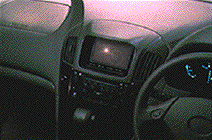|
Science & Technology || Sports & Fashion || Search || Back Numbers
INFORMATION ON WHEELS: Car-Navigation Systems Are Getting Smarter June 9, 1998  The latest built-in car-navigation system will come with many services including voice guidance. (Toyota Motor Corp.) Thanks to rapidly evolving car-navigation technology, the automobile is turning into a high-tech information terminal on wheels. You can not only map out your route electronically and get traffic updates but also make restaurant reservations and, soon, access the Internet from your car. Voice Guidance The latest car-navigation system, to be released by a major automaker and other firms in the summer of 1998, will use a hands-free digital cellular phone. The driver will automatically be connected to a service center by touching a button on the system's display panel. The system responds to spoken requests for directions to a destination by prompting automatic verification of the car's location. The service center then gives a verbal reply, and a map showing the shortest route appears on the screen. The driver does not even have to look at the screen, for spoken instructions are issued 300 meters and 100 meters before each intersection. The range of information that can be obtained aurally or on screen also covers traffic updates, news, weather forecasts, and tourist information. Users are also likely to be able to access the Internet and receive e-mail. Four similar services have already been offered since autumn 1997. One service allows you to reserve tables at a restaurant by specifying the neighborhood, type of cuisine, and whether the meal is a personal or business outing. About half the restaurants in the database have photos, and if you like the look of one, you can dial the restaurant by just pressing a button. All four service providers are working to improve the scope and contents of services they offer.
A big advance in car-navigation convenience came with the launch of the Vehicle Information and Communication System (VICS), developed jointly by the National Police Agency, the Ministry of Construction, and the Ministry of Posts and Telecommunications. VICS provides drivers with updated data on traffic jams, accidents, road construction, shortest routes, and parking availability--supplied by the police and Japan Highway Public Corp.--through roadside beacons and FM multiplex broadcasts. VICS was introduced in 1996 in the metropolitan area and along the expressway stretching from Tokyo to Kobe, and it is now available nearly throughout the country. VICS-compatible car-navigation systems evolved in tandem with the development of this technology. A further advance came in 1997, when systems capable of handling digital videodisks (DVDs) became commonplace. DVDs have far greater capacity to store digital maps than the CD-ROMs they are replacing. Fewer than 40,000 car-navigation systems were sold in 1992, but they have since more than doubled their sales every year, with over 1 million units being sold in 1997. There is still plenty of room for growth, however. The number of mobile phones in circulation is over 30 million, and the Japanese own around 60 million cars. If 10% of these car owners install navigation systems, that would push the market into the 6 million range. Car-navigation systems are expected to evolve even further with the advance of two-way telecommunications services utilizing mobile phones.
 Edited by Japan
Echo Inc. based on domestic Japanese news sources. Articles
presented here are offered for reference purposes and do not
necessarily represent the policy or views of the Japanese
Government. Edited by Japan
Echo Inc. based on domestic Japanese news sources. Articles
presented here are offered for reference purposes and do not
necessarily represent the policy or views of the Japanese
Government.
|
